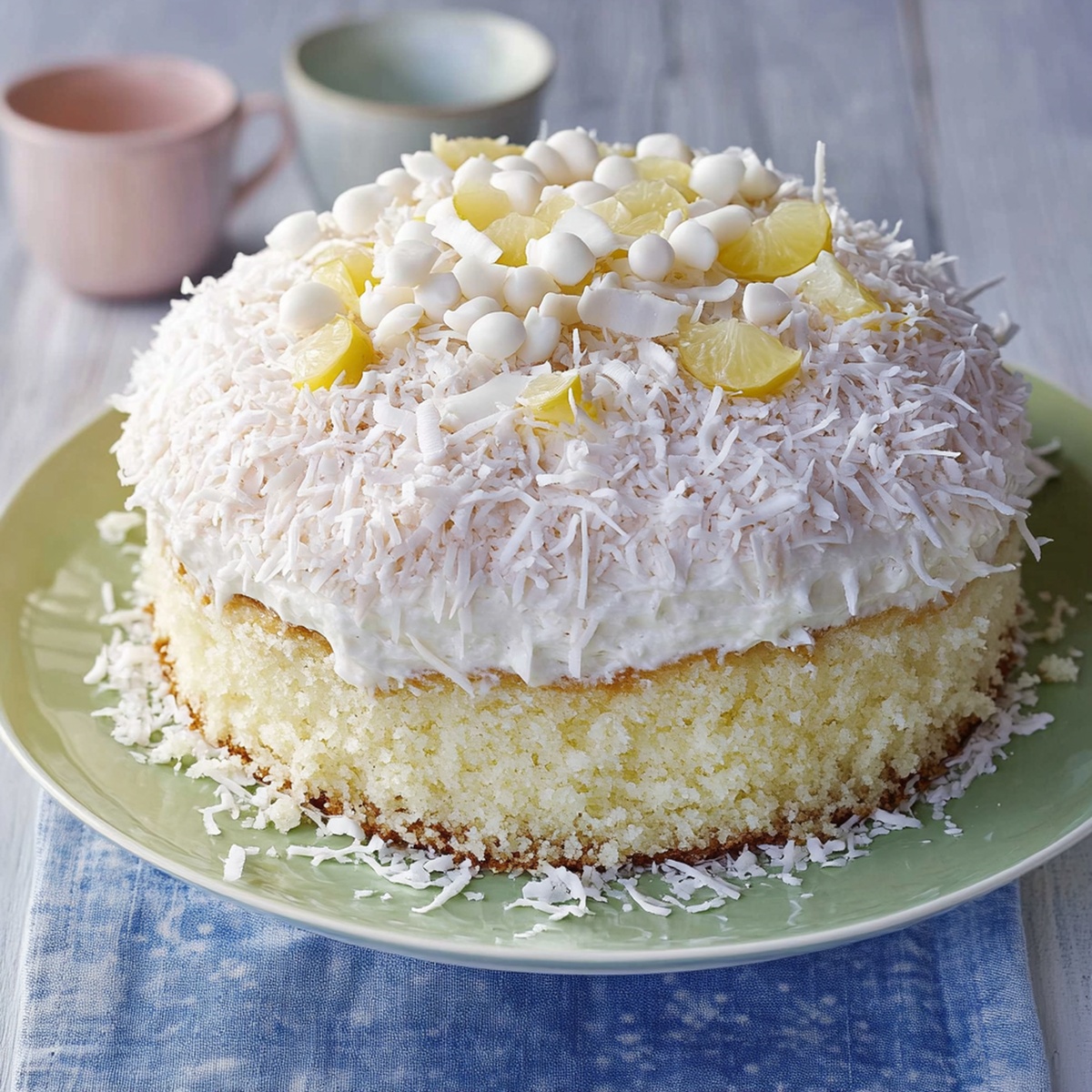Dreamy Coconut Lemon Cake Recipe: A Slice of Sunshine
Sweet memories often spark when you whip up a delightful coconut lemon cake that instantly brightens any gathering.
Sunshine bursts through creamy layers of tropical delight.
Zesty citrus notes dance with smooth coconut undertones, creating a dessert that feels like a warm embrace.
Subtle hints of brightness peek through each tender crumb.
Baking this treat becomes an adventure of flavor and texture.
Home kitchens will buzz with excitement as the aroma fills every corner.
Slice into pure joy and let each bite transport you to a blissful culinary moment.
Coconut Lemon Cake Bursts of Tropical Flavor
Ingredients for Zesty Coconut Lemon Cake
Dry Ingredients:Wet Ingredients:Flavor Enhancers:How to Bake a Light, Tropical Lemon Cake
Step 1: Prepare Baking Station
Crank up the oven to a toasty 350°F (175°C).
Generously coat two round cake pans with butter or cooking spray to prevent sticking.
Set these ready pans aside.
Step 2: Create Dry Mixture
In a spacious mixing bowl, combine the dry ingredients using a whisk:Blend these ingredients thoroughly and set the bowl aside.
Step 3: Whip Creamy Base
Grab another large bowl and cream together:Beat these ingredients until they transform into a light, fluffy mixture.
Introduce eggs one at a time, blending completely after each addition.
Fold in fresh lemon zest and juice for a bright, zingy flavor.
Step 4: Merge Wet and Dry Ingredients
Slowly incorporate the dry mixture into the wet ingredients.
Alternate adding dry ingredients with milk, mixing gently until just combined.
Sprinkle in shredded coconut flakes, stirring until evenly distributed.
Step 5: Bake Cake
Divide the batter equally between the prepared cake pans.
Slide the pans into the preheated oven and bake for 25-30 minutes.
Check doneness by inserting a toothpick – it should come out clean with no wet batter.
Step 6: Cool and Rest
Allow the cakes to rest in their pans for 10 minutes.
Carefully transfer to wire cooling racks, letting them cool completely before frosting or serving.
Tips for Moist Cake and Creamy Frosting
Storing and Enjoying Coconut Lemon Cake
Pairing Ideas for Coconut Lemon Cake
Flavor Variations on Coconut Lemon Cake
FAQs
The bright, tangy lemon cuts through the rich, creamy coconut, creating a balanced and refreshing flavor profile that’s both tropical and zesty.
Both fresh and dried coconut flakes work great. If using fresh, ensure it’s finely shredded; for dried, unsweetened coconut flakes provide the best texture and flavor.
The batter should look smooth and creamy, with no flour streaks visible. Mix until ingredients are just combined to prevent overmixing, which can make the cake tough.
Yes, room temperature eggs, butter, and milk blend more evenly, creating a smoother batter and helping the cake rise more consistently during baking.
Print
Coconut Lemon Cake Recipe
- Total Time: 45 minutes
- Yield: 8 1x
Description
Sweet paradise awaits with this coconut lemon cake, a delightful dessert that blends tropical richness and citrus brightness. Zesty lemon and creamy coconut dance together, creating a refreshing treat perfect for summer gatherings or intimate afternoon delights you’ll savor.
Ingredients
Main Ingredients:
- 3 large eggs
- 1 cup milk
- 1/2 cup (113 grams) unsalted butter, room temperature
- 2 cups (240 grams) all-purpose flour
- 1 cup (200 grams) granulated sugar
Flavoring Ingredients:
- 1 cup unsweetened coconut flakes
- Zest and juice of 2 lemons
Leavening Ingredient:
- 2 teaspoons baking powder
Instructions
- Warm the oven to 350F (175C) and thoroughly coat two circular cake molds with cooking spray or butter.
- Sift together flour, leavening agent, and sodium chloride in a medium mixing container, then set aside.
- Cream softened butter and granulated sweetener until light and airy using an electric mixer, approximately 3-4 minutes.
- Incorporate eggs individually into butter mixture, ensuring complete blending after each addition.
- Grate fresh lemon rind and squeeze citrus juice directly into the creamy base, mixing thoroughly.
- Fold dry ingredients into wet components incrementally, alternating with milk to maintain smooth consistency.
- Gently integrate shredded coconut throughout the batter, distributing evenly with minimal stirring.
- Pour cake mixture equally into prepared baking vessels, smoothing surfaces with a spatula.
- Position pans in preheated oven and bake for 25-30 minutes until a wooden probe emerges clean when inserted.
- Allow cakes to rest in molds for 10 minutes, then carefully transfer to wire cooling platforms.
- Permit complete temperature reduction before proceeding with frosting or serving.
Notes
- Swap out regular flour for gluten-free flour blend to make this cake suitable for those with gluten sensitivities.
- Toast coconut flakes beforehand to enhance their nutty flavor and add a delightful crunch to the cake’s texture.
- Use room temperature ingredients to ensure smoother mixing and a more consistent cake batter.
- For a dairy-free version, replace milk with coconut milk and use plant-based butter alternatives.
- Prep Time: 15 minutes
- Cook Time: 30 minutes
- Category: Desserts
- Method: Baking
- Cuisine: American
Nutrition
- Serving Size: 8
- Calories: 320
- Sugar: 14 g
- Sodium: 180 mg
- Fat: 15 g
- Saturated Fat: 9 g
- Unsaturated Fat: 4 g
- Trans Fat: 0 g
- Carbohydrates: 43 g
- Fiber: 1 g
- Protein: 5 g
- Cholesterol: 70 mg


Jack Sullivan
Founder & Culinary Storyteller
Expertise
Single-recipe development with a narrative approach, Culinary storytelling and food history, Seasonal and regional ingredient utilization, Home cooking techniques adapted for modern kitchens
Education
New England Culinary Institute (Montpelier, VT)
Certificate in Culinary Arts
Focused on farm-to-table cooking, sustainable practices, and modern plating techniques.
Asheville-Buncombe Technical Community College
Associate Degree in Culinary Arts
Emphasized Southern Appalachian cuisine and local ingredient sourcing.
Jack grew up surrounded by smoky skillets and handwritten recipes in the mountains of North Carolina. His roots in Appalachian cooking shaped the way he sees food – as something that connects people, tells a story, and holds meaning.
With hands-on training and a background in sustainable, regional cooking, Jack started Boil And Broil to make meaningful meals more accessible. He’s all about one-dish recipes that are simple to follow but rich with flavor and history.